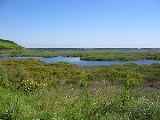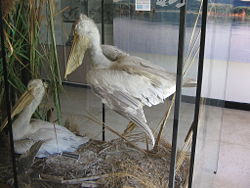
Srebarna Nature Reserve
Encyclopedia
The Srebarna Nature Reserve (Природен резерват Сребърна, Priroden rezervat Srebarna) is a nature reserve
in northeastern Bulgaria
(Southern Dobruja
), near the village of the same name, 18 km west of Silistra
and 2 km south of the Danube
. It comprises Lake Srebarna and its surroundings and is located on the Via Pontica
, a bird migration route between Europe
and Africa
.
The reserve embraces 6 km² of protected area and a buffer zone of 5.4 km². The lake's depth varies from 1 to 3 m. There is a museum constructed, where a collection of stuffed species typical for the reserve is arranged.
, but was returned to Bulgaria in 1940, when the area was visited once again by Petrov to examine the colonies of birds that nest there.
 The area was proclaimed a nature reserve in 1948 and is a Ramsar site since 1975. The reserve was recognized as World Natural Heritage Site under the 1972 Convention for the Protection of the World Cultural and Natural Heritage and included in the UNESCO
The area was proclaimed a nature reserve in 1948 and is a Ramsar site since 1975. The reserve was recognized as World Natural Heritage Site under the 1972 Convention for the Protection of the World Cultural and Natural Heritage and included in the UNESCO
World Heritage List in 1983.
named Srebrist, who died in the neighbourhood whilst engaging in an unequal battle with the Pechenegs. A second one tells about a boat full of silver (srebro in Bulgarian
) along the shores of the lake. According to a third one, which is regarded as most plausible, the name comes from the silvery reflections on the lake's surface during full moon.
 There are hydrophyte species such as reed
There are hydrophyte species such as reed
in and around the lake. The reserve is home to 139 plant species, 11 of them are in danger of extinction outside the territory of Srebarna.
, the Mute Swan
, the Greylag Goose
, the Marsh Harrier
, the Bluethroat
, heron
s and cormorant
s.
on Livingston Island in the South Shetland Islands
, Antarctica is named after Srebarna.
Nature reserve
A nature reserve is a protected area of importance for wildlife, flora, fauna or features of geological or other special interest, which is reserved and managed for conservation and to provide special opportunities for study or research...
in northeastern Bulgaria
Bulgaria
Bulgaria , officially the Republic of Bulgaria , is a parliamentary democracy within a unitary constitutional republic in Southeast Europe. The country borders Romania to the north, Serbia and Macedonia to the west, Greece and Turkey to the south, as well as the Black Sea to the east...
(Southern Dobruja
Southern Dobruja
Southern Dobruja is an area of north-eastern Bulgaria comprising the administrative districts named for its two principal cities of Dobrich and Silistra...
), near the village of the same name, 18 km west of Silistra
Silistra
Silistra is a port city of northeastern Bulgaria, lying on the southern bank of the lower Danube at the country's border with Romania. Silistra is the administrative centre of Silistra Province and one of the important cities of the historical region of Southern Dobrudzha...
and 2 km south of the Danube
Danube
The Danube is a river in the Central Europe and the Europe's second longest river after the Volga. It is classified as an international waterway....
. It comprises Lake Srebarna and its surroundings and is located on the Via Pontica
Via Pontica
Via Pontica was an ancient Roman road in Thrace along the Black Sea, starting from Byzantium and passing through Mesambria, Apollonia, Odessos, Byzone , Kallatis, Tomi and Istros ....
, a bird migration route between Europe
Europe
Europe is, by convention, one of the world's seven continents. Comprising the westernmost peninsula of Eurasia, Europe is generally 'divided' from Asia to its east by the watershed divides of the Ural and Caucasus Mountains, the Ural River, the Caspian and Black Seas, and the waterways connecting...
and Africa
Africa
Africa is the world's second largest and second most populous continent, after Asia. At about 30.2 million km² including adjacent islands, it covers 6% of the Earth's total surface area and 20.4% of the total land area...
.
The reserve embraces 6 km² of protected area and a buffer zone of 5.4 km². The lake's depth varies from 1 to 3 m. There is a museum constructed, where a collection of stuffed species typical for the reserve is arranged.
History
While Lake Srebarna was studied many times in the past by foreign biologists, the first Bulgarian scientist to take an interest in the area was Aleksi Petrov, who visited the reserve in 1911. In 1913, the whole of Southern Dobrudja was incorporated in RomaniaRomania
Romania is a country located at the crossroads of Central and Southeastern Europe, on the Lower Danube, within and outside the Carpathian arch, bordering on the Black Sea...
, but was returned to Bulgaria in 1940, when the area was visited once again by Petrov to examine the colonies of birds that nest there.

UNESCO
The United Nations Educational, Scientific and Cultural Organization is a specialized agency of the United Nations...
World Heritage List in 1983.
Legends
There are several legends about the origin of the lake's name. The one is about a khanKhan (title)
Khan is an originally Altaic and subsequently Central Asian title for a sovereign or military ruler, widely used by medieval nomadic Turko-Mongol tribes living to the north of China. 'Khan' is also seen as a title in the Xianbei confederation for their chief between 283 and 289...
named Srebrist, who died in the neighbourhood whilst engaging in an unequal battle with the Pechenegs. A second one tells about a boat full of silver (srebro in Bulgarian
Bulgarian language
Bulgarian is an Indo-European language, a member of the Slavic linguistic group.Bulgarian, along with the closely related Macedonian language, demonstrates several linguistic characteristics that set it apart from all other Slavic languages such as the elimination of case declension, the...
) along the shores of the lake. According to a third one, which is regarded as most plausible, the name comes from the silvery reflections on the lake's surface during full moon.
Flora

Phragmites
Phragmites, the Common reed, is a large perennial grass found in wetlands throughout temperate and tropical regions of the world. Phragmites australis is sometimes regarded as the sole species of the genus Phragmites, though some botanists divide Phragmites australis into three or four species...
in and around the lake. The reserve is home to 139 plant species, 11 of them are in danger of extinction outside the territory of Srebarna.
Fauna
A wide variety of fauna exists in the area. 39 mammal, 21 reptile and amphibian and 10 fish species inhabit the reserve, which is most famous for the 179 bird species that nest on its territory, some of which include the Dalmatian PelicanDalmatian Pelican
The Dalmatian Pelican is a member of the pelican family. It breeds from southeastern Europe to India and China in swamps and shallow lakes. The nest is a crude heap of vegetation....
, the Mute Swan
Mute Swan
The Mute Swan is a species of swan, and thus a member of the duck, goose and swan family Anatidae. It is native to much of Europe and Asia, and the far north of Africa. It is also an introduced species in North America, Australasia and southern Africa. The name 'mute' derives from it being less...
, the Greylag Goose
Greylag Goose
The Greylag Goose , Anser anser, is a bird with a wide range in the Old World. It is the type species of the genus Anser....
, the Marsh Harrier
Marsh harrier
The marsh harriers are birds of prey of the harrier subfamily. They are medium-sized raptors and the largest and broadest-winged harriers. Most of them are associated with marshland and dense reedbeds...
, the Bluethroat
Bluethroat
The Bluethroat is a small passerine bird that was formerly classed as a member of the thrush family Turdidae, but is now more generally considered to be an Old World flycatcher, Muscicapidae...
, heron
Heron
The herons are long-legged freshwater and coastal birds in the family Ardeidae. There are 64 recognised species in this family. Some are called "egrets" or "bitterns" instead of "heron"....
s and cormorant
Cormorant
The bird family Phalacrocoracidae is represented by some 40 species of cormorants and shags. Several different classifications of the family have been proposed recently, and the number of genera is disputed.- Names :...
s.
Honour
Srebarna GlacierSrebarna Glacier
Srebarna Glacier on Livingston Island in the South Shetland Islands, Antarctica draining southeast of the Great Needle Peak and Serdica Peak in Levski Ridge, Tangra Mountains to enter Bransfield Strait between Aytos Point and M'Kean Point. Extending 2.3 km in southwest-northeast direction and 1.8...
on Livingston Island in the South Shetland Islands
South Shetland Islands
The South Shetland Islands are a group of Antarctic islands, lying about north of the Antarctic Peninsula, with a total area of . By the Antarctic Treaty of 1959, the Islands' sovereignty is neither recognized nor disputed by the signatories and they are free for use by any signatory for...
, Antarctica is named after Srebarna.

